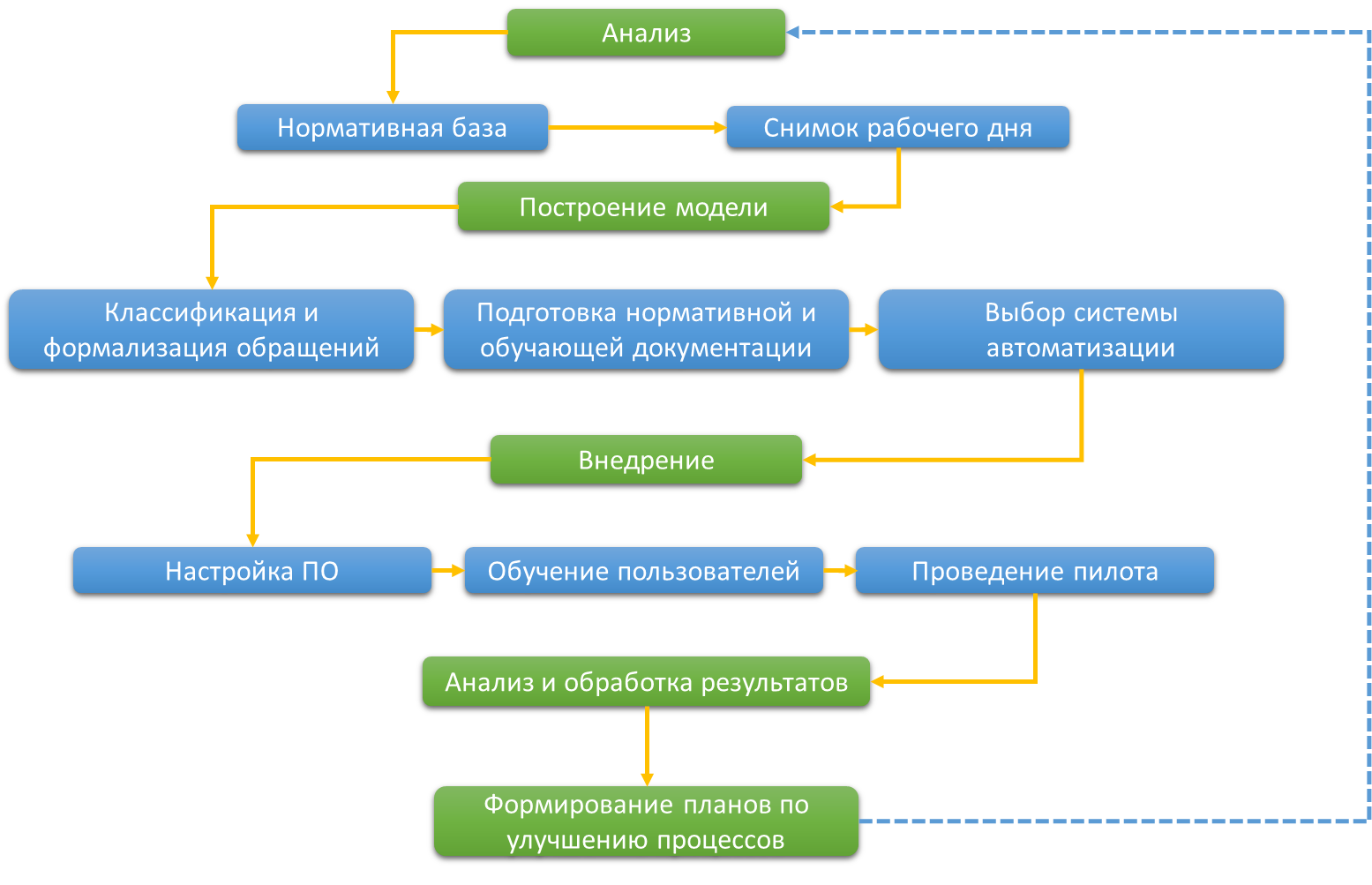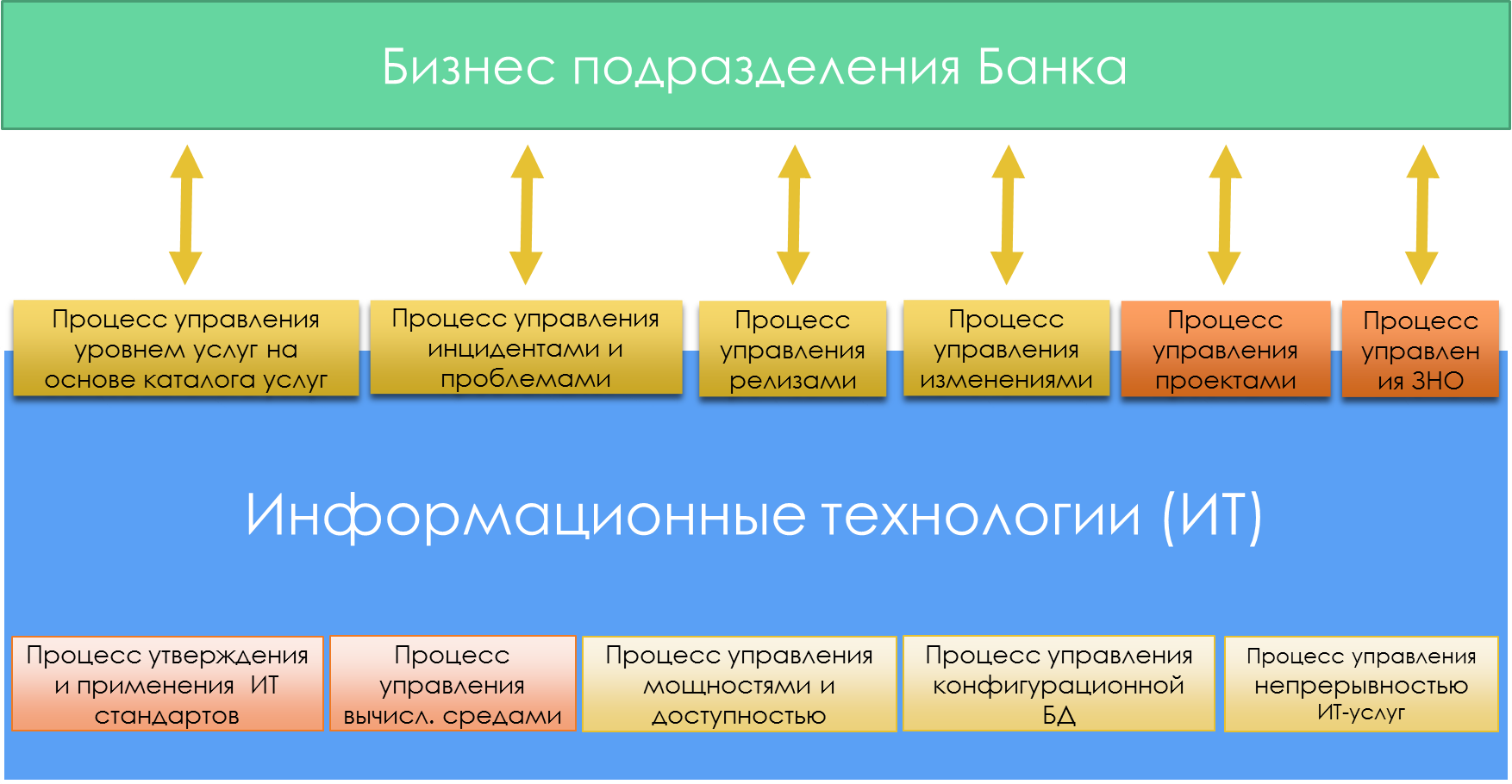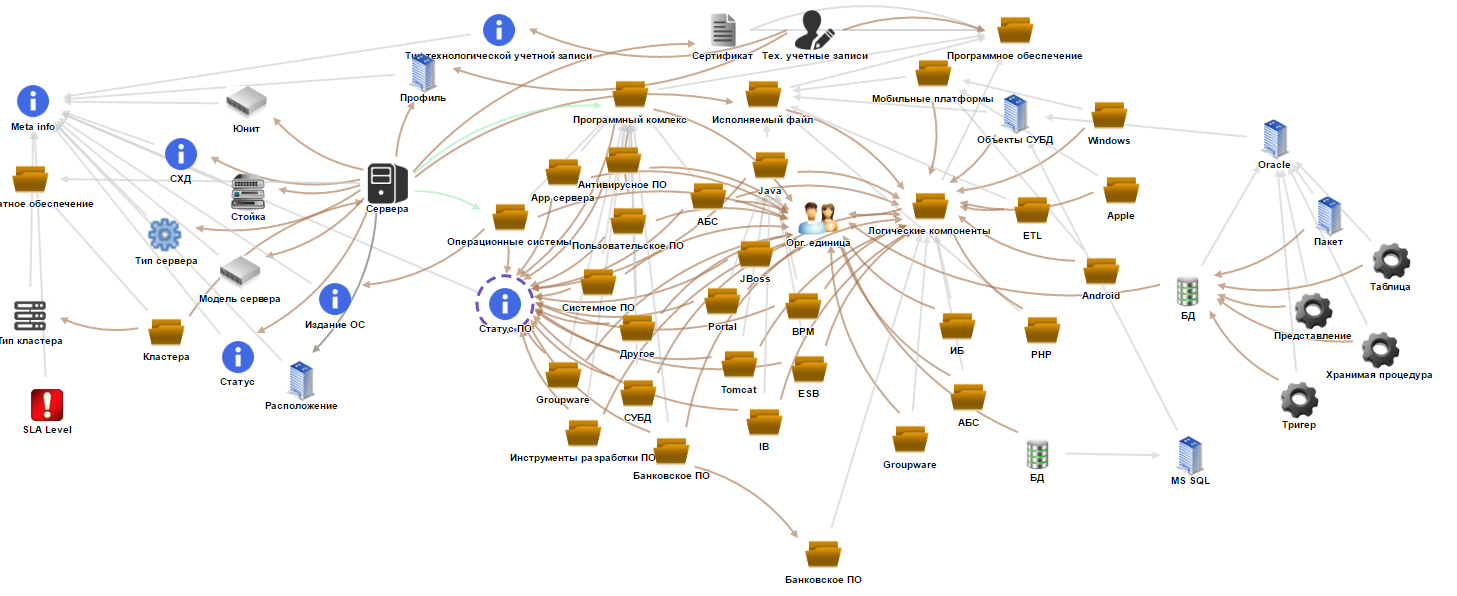Automation of IT services
Good afternoon, dear Habr! I will share some experience in the organization of the IT service of the Bank. The article will not be loaded with a description of the bureaucratic components that I performed to achieve the goal and, I hope, my experience will be useful to you.
It all started with the fact that at the beginning of 2016 I was invited to work at a small Ukrainian Bank as an information systems architect. And one of the tasks that passed to me from the last team was the task of organizing the work of the IT service in accordance with the service-resource model. Yes, the task is certainly not related to the architecture of IP, but it served as a challenge for me.
Factors affecting the success of the task:
')
All the activities that were performed in the framework of this process, I divided conditionally into a number of stages:

Stage 1. Study of regulatory documentation
The first stage of work was the study of the existing model of the IT service, which I began by studying the regulatory documents of the Bank.
The main regulatory documents registered in the electronic document management system (EDMS) and regulating the activities of the IT service:
There were also another two dozen provisions, some of which do not relate to the work of the IT service at all, but the IT service acted as the owner of these provisions.
After studying the documents, the activities of the IT service (if it functioned fully according to these processes) began to resemble a kind of patchwork. And the processes regulated by these documents pushed the IT service away from the business, reducing the effectiveness of the organization (the author’s opinion).
2. Stage. Assessment of the current situation in the IT service
The second stage I planned for myself to take a snapshot of the working day of an IT service worker. I chose several employees from three main areas (Development, Support, Infrastructure). After conducting a series of meetings with the control group (interviewing) and preparing (training, instructing) for the process of “photographing”, observation forms were prepared, which reflected the chosen classification of time expenditures and started collecting information.
The goals set in this work:
During the selected period, the control group formed the documentation. After the process was completed, a timeout was taken to process the results obtained.
Key findings that were obtained during the analysis:
As a result, the provision of services lagged far behind the needs of the business.
Stage 3. Classification of IT applications
The next step is building the service model of the IT service. For this, a model of interaction between business units and the IT service was built on the basis of requests, and the classical approach was chosen (the most prompt solution to incidents and problems, in terms of minimizing business downtime).
All calls to IT were classified into 3 main types:
The request for service (ZNO) was divided into several compound applications: Standard ZN, Non-standard ZN, Request for information.
Visually, the scheme can be represented as follows:

The division into support lines was organized and worked in the existing process and this greatly facilitated the transition to a new management model. In the existing model, 1 and 3 support lines were for the Bank a service purchased on the market (outsourcing). Changes in this strategy, IT services in the short term is not expected.
Thus, the Bank was attended by 3 sources of receipt of appeals to the Bank’s IT service:
Additionally, as part of this stage, an IT services catalog was created, an SLA for the provision of the service was established by an expert, a description of the services was prepared for entering into an SLA with the business.
Stage 4. Building a service model and preparing regulatory documentation
Returning to the existing documents, it was decided to cancel them completely. And the basis of new documents went to “ITIL own cooking”. Of the existing regulatory documents planned to leave only a document on project management.
In the picture below, the expected state of the IT service and the processes governing the work of the department are visualized.

On the formation of documents took about a month. A lot of attention was paid to the change management process, since the task was optimized in the Time-To-Market part, and the classical process (which is part of ITIL) greatly slowed down this indicator. The change management process includes elements of Scrum.
Stage 5. Choosing a tool to automate the work of ServiceDesk
After the classification of all possible calls and the regulation of processes, the task of automating the activities and implementing the ServiceDesk system arose.
The following functions were assigned to ServiceDesk:
The choice was made between several solutions: Atlassian Jira (positive experience outside the Bank), HP Service Manager (recommendations from contractors), IBM Control Desk (solution from a strategic partner).
For the pilot, the victory was given to Atlassian (trial version), the key factors were the speed of implementation and support for the Scrum methodology (perhaps in the next article I will tell you which parts of the methodology were transferred and used in the change management part and what positive effect was achieved due to introduction).
Stage 6. Implementing a new IT service model
After all the preparations were made, I proceeded to the practical part of the issue, including customization of the ServiceDesk system. As part of the task it was necessary to perform:
We will not dive into the detail of these works, since a separate article can be written on the completed scope of work. But I want to note the construction of the CMDB database. Since the connections between the QE (configuration elements) are built, after building the CMDB logical structure, the following picture was obtained:

The next step is the formation of a pilot group on the part of the business, whose appeals were planned in the first step to be transferred to a new interaction model. Several stages of IT service training were conducted, in part of which a pilot group from among the Bank's business users participated.
Next, the system was launched in a pilot mode, all moments were rolled back, additional settings were made to automate the system (the workflow, user fields, directories, screens were set up).
After the pilot was completed, a decision was made to implement the solution and transition to pilot industrial operation, communication was conducted to all Bank divisions, the initial catalog of services was set up, and a transition period for receiving calls through outdated channels was defined.
Another important point in the implementation of ServiceDesk was setting up the Customer Satisfaction service. What does it mean - after the completion of the processing of the request for the initiator, an e-mail with the text leaves where it is proposed to evaluate the work of the IT service (5-point assessment). Clicking on the assessment, additionally opened a browser window in which you could leave a comment. Naturally, all data was stored in the context of the appeal.
During the design and implementation of the new service and resource management model of the IT service, the criteria for the quality of work were determined and the mechanisms for control and monitoring of processes were formed. New roles were created and existing roles were redistributed, and areas of responsibility and authority of IT service workers were defined. And, not least, an automated system (ServiceDesk) was introduced to support the execution of IT service management processes.
A month has passed since the start of the pilot operation of the ServiceDesk system, statistics have been collected, and user feedback has been received. The system officially registered 700 calls, 109 user reviews, the average rating of IT services 4.8 (out of 5 points), more than 80% of the tasks were performed taking into account the exposed SLAs.
Next steps are process optimization, integration with the Bank’s systems (IDM, EDMS, internal corporate portal), improvement of the organizational structure of the IT service, transfer of the Bank’s counterparties to interaction with the IT service through the Bank’s ServiceDesk system.
It all started with the fact that at the beginning of 2016 I was invited to work at a small Ukrainian Bank as an information systems architect. And one of the tasks that passed to me from the last team was the task of organizing the work of the IT service in accordance with the service-resource model. Yes, the task is certainly not related to the architecture of IP, but it served as a challenge for me.
Factors affecting the success of the task:
')
- Management support (Bank level);
- The desire to modernize the IT service (both from the business users and from the IT service workers);
- Personal experience in this management model at previous places of work.
All the activities that were performed in the framework of this process, I divided conditionally into a number of stages:

Stage 1. Study of regulatory documentation
The first stage of work was the study of the existing model of the IT service, which I began by studying the regulatory documents of the Bank.
The main regulatory documents registered in the electronic document management system (EDMS) and regulating the activities of the IT service:
- Task setting procedure for modifying existing software and automating business processes
- The procedure for analyzing applications for software modification and business process automation
- Procedure for software modification
- Software Development Procedure
- Software testing order
- Procedure for centralized configuration of products and services
- The procedure for organizing time synchronization in the corporate network
- Project Management Procedure
- The order of processing appeals of internal users.
There were also another two dozen provisions, some of which do not relate to the work of the IT service at all, but the IT service acted as the owner of these provisions.
After studying the documents, the activities of the IT service (if it functioned fully according to these processes) began to resemble a kind of patchwork. And the processes regulated by these documents pushed the IT service away from the business, reducing the effectiveness of the organization (the author’s opinion).
2. Stage. Assessment of the current situation in the IT service
The second stage I planned for myself to take a snapshot of the working day of an IT service worker. I chose several employees from three main areas (Development, Support, Infrastructure). After conducting a series of meetings with the control group (interviewing) and preparing (training, instructing) for the process of “photographing”, observation forms were prepared, which reflected the chosen classification of time expenditures and started collecting information.
The goals set in this work:
- Determining the structure of working time
- Identify wasted time in workflow
- Identifying the causes of non-compliance
During the selected period, the control group formed the documentation. After the process was completed, a timeout was taken to process the results obtained.
Key findings that were obtained during the analysis:
- Many channels of receipt of tasks (mail, call, sms, vibeer, etc.)
- 80% of tasks go ad hoc
- Task priorities are constantly changing.
- Managers do not have the ability to plan work.
- There is no harmony in the development of information systems
- There are no "established rules of the game" when implementing changes
As a result, the provision of services lagged far behind the needs of the business.
Stage 3. Classification of IT applications
The next step is building the service model of the IT service. For this, a model of interaction between business units and the IT service was built on the basis of requests, and the classical approach was chosen (the most prompt solution to incidents and problems, in terms of minimizing business downtime).
All calls to IT were classified into 3 main types:
- Request for change (ZNI, CR, RfC)
- Incident (including Problem type)
- Service Request (ZNO, SR, RfS)
The request for service (ZNO) was divided into several compound applications: Standard ZN, Non-standard ZN, Request for information.
Visually, the scheme can be represented as follows:

The division into support lines was organized and worked in the existing process and this greatly facilitated the transition to a new management model. In the existing model, 1 and 3 support lines were for the Bank a service purchased on the market (outsourcing). Changes in this strategy, IT services in the short term is not expected.
Thus, the Bank was attended by 3 sources of receipt of appeals to the Bank’s IT service:
- 1 line of support (Main treatment: incident, consultation, problem)
- Business user (Main messages: IT service, consultation, change in software functionality)
- 3 line of support (Main requests: configuration change, consultation)
Additionally, as part of this stage, an IT services catalog was created, an SLA for the provision of the service was established by an expert, a description of the services was prepared for entering into an SLA with the business.
Stage 4. Building a service model and preparing regulatory documentation
Returning to the existing documents, it was decided to cancel them completely. And the basis of new documents went to “ITIL own cooking”. Of the existing regulatory documents planned to leave only a document on project management.
In the picture below, the expected state of the IT service and the processes governing the work of the department are visualized.

On the formation of documents took about a month. A lot of attention was paid to the change management process, since the task was optimized in the Time-To-Market part, and the classical process (which is part of ITIL) greatly slowed down this indicator. The change management process includes elements of Scrum.
Stage 5. Choosing a tool to automate the work of ServiceDesk
After the classification of all possible calls and the regulation of processes, the task of automating the activities and implementing the ServiceDesk system arose.
The following functions were assigned to ServiceDesk:
- Single entry point for Bank users
- Control of the time of execution of requests
- The possibility of a clear prioritization of appeals
- Knowledge base
- Manageability and control of IT infrastructure changes
- Building reporting
The choice was made between several solutions: Atlassian Jira (positive experience outside the Bank), HP Service Manager (recommendations from contractors), IBM Control Desk (solution from a strategic partner).
For the pilot, the victory was given to Atlassian (trial version), the key factors were the speed of implementation and support for the Scrum methodology (perhaps in the next article I will tell you which parts of the methodology were transferred and used in the change management part and what positive effect was achieved due to introduction).
Stage 6. Implementing a new IT service model
After all the preparations were made, I proceeded to the practical part of the issue, including customization of the ServiceDesk system. As part of the task it was necessary to perform:
- Establishing projects, types of requests, setting up fields, description of business processes (workflow)
- Setting up service catalog, SLA counters
- Description and configuration of the role model
- Filling CMDB base (configuration database)
- Preparation of user training materials
We will not dive into the detail of these works, since a separate article can be written on the completed scope of work. But I want to note the construction of the CMDB database. Since the connections between the QE (configuration elements) are built, after building the CMDB logical structure, the following picture was obtained:

The next step is the formation of a pilot group on the part of the business, whose appeals were planned in the first step to be transferred to a new interaction model. Several stages of IT service training were conducted, in part of which a pilot group from among the Bank's business users participated.
Next, the system was launched in a pilot mode, all moments were rolled back, additional settings were made to automate the system (the workflow, user fields, directories, screens were set up).
After the pilot was completed, a decision was made to implement the solution and transition to pilot industrial operation, communication was conducted to all Bank divisions, the initial catalog of services was set up, and a transition period for receiving calls through outdated channels was defined.
Another important point in the implementation of ServiceDesk was setting up the Customer Satisfaction service. What does it mean - after the completion of the processing of the request for the initiator, an e-mail with the text leaves where it is proposed to evaluate the work of the IT service (5-point assessment). Clicking on the assessment, additionally opened a browser window in which you could leave a comment. Naturally, all data was stored in the context of the appeal.
Conclusion
During the design and implementation of the new service and resource management model of the IT service, the criteria for the quality of work were determined and the mechanisms for control and monitoring of processes were formed. New roles were created and existing roles were redistributed, and areas of responsibility and authority of IT service workers were defined. And, not least, an automated system (ServiceDesk) was introduced to support the execution of IT service management processes.
A month has passed since the start of the pilot operation of the ServiceDesk system, statistics have been collected, and user feedback has been received. The system officially registered 700 calls, 109 user reviews, the average rating of IT services 4.8 (out of 5 points), more than 80% of the tasks were performed taking into account the exposed SLAs.
Next steps are process optimization, integration with the Bank’s systems (IDM, EDMS, internal corporate portal), improvement of the organizational structure of the IT service, transfer of the Bank’s counterparties to interaction with the IT service through the Bank’s ServiceDesk system.
Source: https://habr.com/ru/post/310466/
All Articles